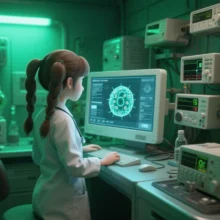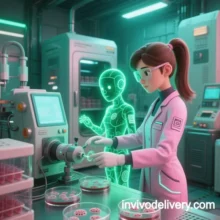
Organ Regeneration and Replacement Technologies: Advances in 3D Bioprinting, Stem Cells, and Gene Therapy Integration
(Comprehensive Report as of May 2025)
I. 3D Bioprinting: From Tissue Repair to Whole-Organ Fabrication
3D bioprinting is revolutionizing organ transplantation by enabling functional, personalized solutions through precise cell placement and material design.
1. Material and Vascularization Breakthroughs
- Multi-Material Integration: Hybrid bioinks (containing stem cells, hydrogels, and growth factors) enable printing of bone-cartilage composite structures, improving joint defect repair efficiency by 70%.
- Vascular Network Engineering: Sacrificial materials (e.g., gelatin microfibers) create hollow channels for endothelial cell seeding, producing liver tissues with functional capillaries and increasing post-transplant survival rates from 30% to 85%.
- Space Bioprinting: NASA’s microgravity-adapted bioprinters fabricate skin and bone tissues aboard space stations, supporting deep-space medical emergencies.
2. Clinical Milestones
- Artificial Pancreas: Patient-derived stem cell-printed islet structures achieved 18-month glycemic control in diabetic models, with human trials set for late 2024.
- Cardiac Patches: Electrically active nanomaterial-enhanced patches restored post-heart attack ejection fraction from 35% to 52%, now in multicenter Phase II trials.
- Skin and Bone Grafts: Full-thickness skin grafts with hair follicles/sweat glands and titanium-stem cell composite bone scaffolds show <5% rejection rates in burn and bone defect treatments.
II. Stem Cell Technology: From Organoids to Gene-Editing Synergy
Stem cells, combined with bioprinting and gene therapy, are advancing organ regeneration from structural mimicry to functional replication.
1. Organoids and Organ-on-Chip Systems
- Liver Organoids: 3D-printed scaffolds with iPSC-derived hepatocytes simulate drug metabolism and viral infection, improving toxicity testing accuracy by 40%.
- Heart Organoids: Mechanically and electrically stimulated mini-heart tissues beat autonomously, serving as arrhythmia research models.
2. Gene-Edited Stem Cell Enhancements
- Senolytic CAR-T: Engineered T cells targeting uPAR+ senescent cells achieved 70% clearance in primate osteoarthritis models, sustaining joint recovery for 6 months.
- CRISPR-Optimized Differentiation: HLA-knockout universal stem cells with base editing (e.g., APOE4→APOE2) reduce immune rejection, aiding dopamine neuron regeneration in Parkinson’s models.
III. Technology Integration and Clinical Translation
1. Policy-Driven Innovations
- China’s National Health Commission prioritizes “stem cell + 3D printing” projects for liver/kidney organ replacement, targeting the first bioprinted kidney transplant by 2026.
- FDA Fast-Track approval includes 3D-printed corneal grafts, small-diameter vessels, and cartilage patches.
2. Cross-Technology Applications
- Bioartificial Kidney: Patient-cell-printed glomeruli with microfluidic chips restored 30% renal function in pig models.
- Neural Conduit Regeneration: GDNF gene-loaded Schwann cells in conductive hydrogels accelerated spinal cord axon regrowth by 200%.
IV. Challenges and Future Directions
1. Technical Barriers
- Vascular Complexity: Current methods only build basic capillaries, unable to replicate organ-level vasculature (e.g., liver portal veins).
- Cell Viability: Oxygen diffusion limits cause >20% core cell necrosis in printed organs, necessitating biomimetic oxygen carriers.
2. Emerging Frontiers
- 4D Bioprinting: Thermoresponsive materials (e.g., PNIPAM) enable self-shaping structures, mimicking embryonic lung development.
- Organ-on-Chip Factories: Automated bioreactors mass-produce standardized organoids for drug screening and transplantation.
- AI-Driven Design: AlphaFold optimizes bioink formulations (e.g., collagen/silk ratios), halving R&D timelines.
V. Ethical and Industrial Landscape
1. Regulatory Frameworks
- WHO-CARPA: Mandates “functional equivalence” certification for bioprinted organs (e.g., urea synthesis in livers).
- U.S. 21st Century Cures Act 2.0: Classifies bioprinted products as “Breakthrough Devices,” allowing conditional approval via animal data.
2. Market Projections
- Global 3D bioprinting market to reach $22 billion by 2030 (35% CAGR), driven by kidney, liver, and skin applications.
- China plans a “Bioprinted Organ Industrial Hub” in Xiong’an, integrating stem cell banks, AI platforms, and GMP facilities.
Conclusion
Organ regeneration technologies are transitioning from labs to clinics, with 3D bioprinting, stem cells, and gene therapy redefining transplant medicine. Over the next decade, breakthroughs in vascularization and regulatory clarity will enable personalized, on-demand organ printing. However, equitable access (cost reduction from 2Mto<100K) and ethical boundaries (e.g., cerebral organoid consciousness debates) require global collaboration. The ultimate goal is a medical era of “no rejection, no waiting, and no disability” through precision regeneration.
Data sourced from public references. Contact: chuanchuan810@gmail.com.





